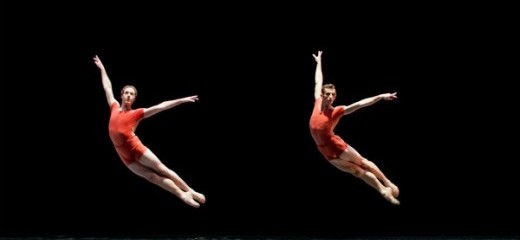
Photo: Alexander Iziliaev
Maintaining Boundaries
by Kilian Kröll
[Pictured: Pennsylvania Ballet Company Members Tyler Savoie and Andrew Daly in William Forsythe’s The Vertiginous Thrill of Exactitude ]
In the absence of having a history of watching the choreographers and the company I am supposed to review, let me reflect for a moment on my current dilemma as a dance critic.
Coming from the nothing-is-too-weird-to-be-performed contemporary dance world, I went out on a limb by agreeing to write about Pennsylvania Ballet's opening night of Pushing Boundaries: Forsythe and Neenan. The presenting artists are big names with long-standing reputations and large followings in the ballet world. Based on the marketing, I was expecting to see pioneering new work in a traditional genre.
Instead, the program, consisting of three short repertory pieces and two long intermissions, entertained me but didn’t get me to think new thoughts about dance. A classical ballet audience used to seeing time-honored work might disagree, but to me the program – contrary to its title’s promise – maintained the status quo.
William Forsythe’s 12-minute
The Vertiginous Thrill of Exactitude, the oldest work on the program, stimulated my analytic mind the most. Originally premiered by Ballett Frankfurt in 1996, it was first staged by PA Ballet last February. Five dancers peppered the rapid, jovial and intermittently bombastic last movement of Franz Schubert’s Ninth Symphony (thrashing over the Merriam Theater’s lackluster P.A. system) with super-quick and strictly classical poses, jumps and upright phrases. The three men and two women – the latter dressed in faded green tutus resembling flying saucers – raced against time as they alternated between dancing in synch, mirroring each other, performing antithetical actions, and reuniting in unison.
Forsythe is a giant in the German contemporary ballet world, and although I grew up in Europe where he is revered, I had never seen any of his work before. Working within a circumscribed palette repeated without mercy, Forsythe created a kaleidoscope of the movements any dancer tries to master in ballet class – and brought to light the rigor of these dancers’ training.
What I saw was definitely unlike a lyrical ballet: it abstracted the basic ballet vocabulary to its most elemental and extreme rhythms and geometries. Exactitude did well what many choreographers have attempted since the beginnings of modern dance – i.e., use the ballet form self-consciously – but added little that felt groundbreaking today.
The other two pieces came from Resident Choreographer Matthew Neenan. Although Neenan presented two works – Keep (2009) and 11:11 (2005) – they have fused in my mind as one. The choreographic elements of these works seemed to come from the same bucket of inspiration. And since these pieces look so similar, it is hard to say which frontiers he is edging across.
Neenan himself has come up through the Ballet, dancing in the corps for several years, a fact that clearly showed in the company’s keen response to his directives. In ever-revolving duets and trios, the women lifted their legs to standing splits, hooked their floating calves around their partners’ necks and ended up being twirled around like upside down Christmas trees. The mood was intense, the music overpowering, the partnering clingy, never stopping to let questions – or human tenderness – flourish.
The dances kept pushing forward, however contained within the bounds of Neenan’s signature language that includes walking on heels, men hurling their partners with extreme momentum, and vignettes that resolve as neatly as a gift box with a pretty bow. (Keep, for example, ends with the principal ballerina draped over a spinning barstool in front of a blue-lit backdrop while the curtain closes.) Martha Chamberlin’s vivid costumes flatter the dancers’ bodies, and smartly complement the music, lighting and choreography. Whereas Exactitude’s faded costumes and the dancers’ visible anticipation of the steps revealed Forsythe’s piece as an import, the corps embodied Neenan’s artistry as their own. And in turn, he concocted for the Philly ballet audience a home-cooked meal.
I am not a ballet expert. I admit to being at a loss as to how to position my argument in the grand scheme of ballet history, Pennsylvania Ballet history, and audience memory. If Pushing Boundaries is considered cutting edge on any of these fronts, I’m going to keep searching for works that actually push the limits of traditionalism beyond mere abstraction and physical exertion. In the meantime, however, I’ll keep enjoying eye candy like this production for what it’s worth.
Pushing Boundaries: Forsythe and Neenan, Pennsylvania Ballet, Merriam Theater, February 9-12. No further performances.
By Kilian Kröll
February 23, 2012

